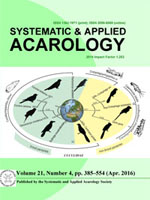The morphological ontogeny, distribution and ecology of Damaeus torquisetosus (Mihelčič, 1955) and Epidamaeus puritanicus (Banks, 1906) were investigated. In the juveniles of D. torquisetosus the legs are longer than the main body, especially leg IV, the prodorsal setae are of medium size, except for short seta in in nymphs, the dorsal setae on gastronotum are long or very long, except for distinctly shorter setae c3 and h2 in larva, seta h3 absent in larva, most gastronotal setae are curved, finely barbed, with flagellate distal part and inserted on apophyses, the cornicle is straight and situated between setal pair lm and epimeral setae are of different lengths. Juveniles of D. torquisetosus differ from the known juveniles of other Damaeus species in the following: absence of seta h3 in the larva, but present in other Dameus species, seta c3 in nymphs is of medium size whereas in most other species it is short. In the juveniles of E. puritanicus legs I, III and IV are as long or slightly longer than the main body, the prodorsal setae are of medium size, curved and barbed, most gastronotal setae are long, except for shorter setae c3, la, lm, h2 and h3 in larva, most dorsal gastronotal setae are curved, finely barbed, distally flagellate, and inserted on apophyses, the cornicle of nymphs is straight and located between setal pair lp and epimeral setae are of similar length. The juveniles of E. puritanicus differ from the known juveniles of other Epidamaeus species in the following: seta h3 present in the larva which is similar to other Epidamaeus species except in E. verrucatus, seta h2 in larva is long, whereas in other species it is short, seta c3 in nymphs of medium size whereas in most other species it is short. Damaeus torquisetosus is known from Iberian Peninsula, whereas E. puritanicus has a holarctic distribution, but both species prefer forest litter.
How to translate text using browser tools
14 April 2016
Morphological ontogeny, distribution and ecology of Damaeus torquisetosus and Epidamaeus puritanicus (Acari: Oribatidae: Damaeidae)
Anna Seniczak,
Stanisław Seniczak,
Sławomir Kaczmarek
ACCESS THE FULL ARTICLE

Systematic and Applied Acarology
Vol. 21 • No. 4
April 2016
Vol. 21 • No. 4
April 2016
juveniles
leg setation
morphology
oribatid mites
stage structure




